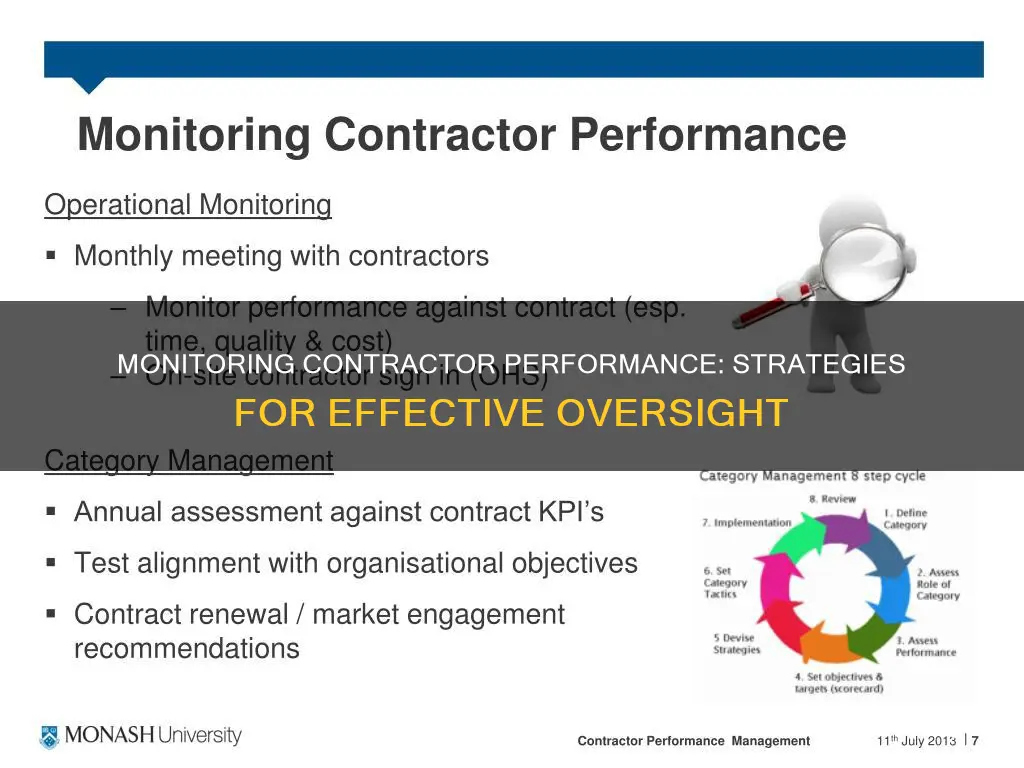
Monitoring contractor performance is an essential skill for professionals across industries. It involves systematically evaluating and assessing the performance of contractors throughout a project or contract. Effective monitoring ensures that contractors meet their obligations, deliver high-quality results, and adhere to timelines. It also helps identify and address performance issues and risks promptly, thereby minimising the chances of project delays, cost overruns, or quality deficiencies.
In this topic, we will explore the key aspects of monitoring contractor performance, including defining clear expectations, establishing regular communication, using performance indicators, conducting inspections and audits, providing feedback, and managing changes and risks. We will also discuss best practices, such as centralising contract information, conducting routine monitoring, and utilising reliable contract monitoring platforms. By the end of this topic, you should be able to implement effective strategies for monitoring contractor performance and ensuring successful project outcomes.
What You'll Learn

Define clear expectations and deliverables
To effectively monitor contractor performance, it is crucial to define clear expectations and deliverables. This involves establishing a shared understanding between all parties involved, encompassing project objectives, scope of work, timelines, and quality standards. Here are some essential components to consider:
Define the Scope and Objectives:
Begin by outlining the overall scope of the project, including the specific goals, targets, and desired outcomes. Clearly communicate the expected results, ensuring that all stakeholders are aligned with the project's purpose and intended impact.
Establish Clear Deliverables:
Break down the project into specific, measurable, and achievable deliverables. Define the tasks, milestones, and outputs that the contractor is expected to deliver. This provides a structured framework for evaluating performance and enables timely course corrections if needed.
Set Timelines and Deadlines:
Construct a detailed project schedule, outlining key dates and deadlines for each phase of the project. Define the expected completion times for various tasks, milestones, and the overall project. This helps in monitoring progress, identifying potential delays, and ensuring timely delivery.
Determine Quality Standards:
Establish clear quality standards and criteria that define successful project outcomes. These standards may include metrics such as completion rate, defect rate, customer satisfaction, and compliance with industry benchmarks. Clear quality standards enable an objective evaluation of the contractor's work and facilitate the identification of areas for improvement.
Communicate Methods and Channels:
Define the methods and channels of communication that will be used throughout the project. This includes determining the frequency and format of communication touchpoints, such as phone calls, emails, meetings, or site visits. Effective communication ensures that all parties remain aligned and enables prompt issue resolution.
Outline Reporting Requirements:
Specify the reporting requirements that the contractor needs to fulfil. This includes determining the type and frequency of progress reports, status updates, and other relevant documentation. Clear reporting requirements enable project stakeholders to track progress effectively and make informed decisions.
By defining clear expectations and deliverables, you set the foundation for successful contractor performance monitoring. This initial step is crucial for avoiding misunderstandings, conflicts, and disputes, as well as providing a clear basis for evaluating the contractor's performance and progress throughout the project's lifecycle.
Asus Monitor Power Cord Length: How Long?
You may want to see also

Establish regular communication
Establishing regular communication is a crucial aspect of monitoring contractor performance. Here are some detailed steps and guidelines to achieve effective communication:
Determine Communication Methods and Channels:
It is essential to determine the agreed-upon communication methods and channels specified in the contract. This can include phone calls, emails, meetings, or site visits. Ensure that these methods are effective and efficient for both parties.
Create a Communication Plan:
Develop a comprehensive communication plan that outlines the frequency, purpose, and participants of each communication activity. This plan should be established at the beginning of the project and communicated to all relevant stakeholders.
Communicate Frequently:
Regular and frequent communication is key to keeping track of the project's status. It helps identify and resolve issues promptly and provides opportunities for feedback and guidance. Ensure that communication occurs as outlined in the communication plan and adjust the frequency as needed to address any emerging concerns.
Document Communication Outcomes:
It is important to document the outcomes and actions of each communication. This creates a record of discussions, decisions made, and follow-up items. It also helps ensure accountability and provides a reference point for future communications and project reviews.
Provide Timely and Constructive Feedback:
Regular feedback is essential for fostering a productive working relationship with contractors. Provide specific and timely feedback, highlighting both positive contributions and areas needing improvement. This ongoing feedback allows contractors to make necessary adjustments and enhances overall performance and project outcomes.
Utilize Technology:
Take advantage of technology tools to facilitate communication and collaboration. For example, use project management software or communication platforms that allow for real-time exchanges and document sharing. This can streamline communication and ensure that all relevant information is easily accessible to team members.
Foster Open and Transparent Communication:
Encourage an open and transparent communication culture. Ensure that all parties feel comfortable voicing their concerns, providing updates, and seeking guidance when needed. This helps build trust and promotes a collaborative environment, which is essential for effective contractor performance monitoring.
By following these steps and maintaining regular communication, project managers can effectively monitor contractor performance, address issues promptly, and drive successful project outcomes.
LCD Monitor: Does Nikon 3500 Have One?
You may want to see also

Use performance indicators
Performance indicators, or key performance indicators (KPIs), are a crucial aspect of monitoring contractor performance. They provide a clear framework to assess whether contractors are meeting expectations and delivering successful outcomes.
When establishing performance indicators, it is essential to define clear and concise metrics that align with the specific project's objectives, scope, and requirements. These indicators should be tailored to the contractor's role and responsibilities and encompass various aspects of project delivery. For instance, in the construction industry, common KPIs include safety incident rates, schedule performance, cost performance, equipment utilisation, and client satisfaction scores.
One of the most critical aspects of performance indicators is their ability to provide measurable data. This allows for an objective evaluation of the contractor's performance and facilitates fair and consistent assessments. By defining specific criteria, organisations can promote accountability, transparency, and a data-driven approach to decision-making.
- Timeliness of deliverables: This measures the contractor's ability to meet deadlines and complete tasks within the expected timeframe.
- Quality of work: Evaluating the quality of the contractor's work ensures that it meets the required standards and client expectations.
- Client satisfaction: Assessing client satisfaction provides valuable insights into the contractor's performance and can be measured through feedback, surveys, or ratings.
- Budget adherence: Monitoring the contractor's ability to stay within the allocated budget helps control costs and identify potential overruns.
- Project milestones achieved: Tracking the completion of key project milestones provides an indication of the contractor's progress and effectiveness.
- Collaboration and teamwork: Evaluating the contractor's ability to work effectively within a team and collaborate with other stakeholders is essential for overall project success.
- Adaptability: Assessing the contractor's adaptability to changing project requirements demonstrates their flexibility and ability to adjust to unforeseen circumstances.
It is important to note that the selection of performance indicators should be tailored to the specific project and industry. Additionally, organisations should regularly review and adjust their indicators to ensure they remain relevant and effective.
By utilising performance indicators effectively, organisations can make data-driven decisions, address any performance issues, and ensure successful project outcomes.
USB Monitor Setup for MacBook: A Simple Guide
You may want to see also

Conduct inspections and audits
Conducting inspections and audits is a crucial aspect of monitoring contractor performance. It involves a formal and systematic process of evaluating the contractor's work against the established standards, contract requirements, and regulations. Here are some detailed steps to conduct effective inspections and audits:
Define the Scope of Inspections and Audits:
Before initiating the inspections and audits, it is essential to define their scope and objectives. This includes identifying the specific areas, milestones, or deliverables that will be subject to inspection. By clearly outlining the scope, you can ensure a focused and comprehensive assessment of the contractor's performance.
Develop a Comprehensive Inspection and Audit Plan:
Create a well-structured plan that outlines the inspection and audit process. This plan should include the frequency, timing, and methods of inspections. It should also incorporate different techniques such as spot checks, scheduled inspections, random sampling, and reviews of the contractor's quality control programs and reports. Ensure that the plan is tailored to the complexity and criticality of the contract.
Conduct On-Site Inspections:
Perform on-site inspections by visiting the contractor's worksite. This allows for a direct observation of the work being performed, including the processes, materials, and personnel involved. On-site inspections provide valuable insights into the contractor's adherence to quality standards, safety protocols, and contract specifications.
Review Documentation and Reports:
Collect and review relevant documentation, such as progress reports, quality control records, and financial status reports. These documents provide a detailed account of the contractor's performance, including technical progress, challenges encountered, staffing, and expenditures. By analyzing these reports, you can identify potential issues, track milestones, and assess the overall quality of the work.
Utilize Performance Indicators:
Establish key performance indicators (KPIs) or metrics that will be used to assess the contractor's performance. These indicators should be quantifiable and aligned with the contract's expectations. Examples of KPIs include completion rate, defect rate, safety record, customer satisfaction, and cost variance. Regularly track these indicators using dashboards, reports, or charts to identify areas where the contractor excels or needs improvement.
Identify Defects, Errors, or Deviations:
During the inspections and audits, be vigilant in identifying any defects, errors, or deviations from the contract requirements and quality standards. These issues may impact the overall quality, safety, or performance of the project. Document these findings and discuss them with the contractor to develop corrective actions and prevent reoccurrences.
Ensure Compliance with Regulations:
In addition to evaluating the contractor's performance, inspections and audits should also verify compliance with relevant regulations and industry standards. This is particularly important in industries with strict safety, legal, or environmental requirements. Ensure that the contractor adheres to applicable laws, codes, and best practices to mitigate risks and ensure the integrity of the project.
Provide Feedback and Follow-up:
After completing the inspections and audits, provide clear and timely feedback to the contractor. Communicate the findings, highlighting both the strengths and areas that require improvement. Collaborate with the contractor to develop action plans for addressing any deficiencies or non-compliant issues. Schedule follow-up inspections or audits to ensure that corrective measures have been effectively implemented.
By following these steps, organizations can effectively conduct inspections and audits as part of their contractor performance monitoring process. This enables them to identify issues early on, ensure compliance, and drive continuous improvement in the contractor's performance, ultimately contributing to the success of the project.
Monitoring Your Child's Apple Devices: A Parent's Guide
You may want to see also

Provide feedback and recognition
Providing feedback and recognition is an essential aspect of monitoring contractor performance. It helps to motivate and improve the contractor's work while also fostering a collaborative and productive working relationship. Here are some detailed guidelines on providing feedback and recognition:
Frequency and Timeliness:
Regular and timely feedback is crucial. It ensures that issues are addressed promptly and enables contractors to make necessary adjustments without causing project delays or the need for rework. Depending on the project's complexity and duration, feedback sessions can be scheduled monthly, quarterly, or at key milestones.
Specificity and Balance:
Feedback should be specific and balanced. Provide clear and detailed examples to illustrate your points, whether praising exemplary performance or addressing areas for improvement. Highlight both the strengths and weaknesses of the contractor's work to maintain a constructive and motivational tone.
Constructiveness:
Feedback should be objective and focused on improving performance. Avoid subjective evaluations or personal criticisms. Instead, offer actionable suggestions and recommendations. Be open to discussing challenges and potential solutions with the contractor to foster a collaborative problem-solving approach.
Formal and Informal Channels:
Utilize both formal and informal feedback channels as agreed upon in the contract. Formal feedback sessions can be scheduled at regular intervals, while informal feedback can be provided more spontaneously to address immediate concerns or achievements.
Communication Methods:
Use the communication methods specified in the contract, such as phone calls, emails, meetings, or site visits. Ensure that feedback is well-documented and communicated clearly, with specific action points and expectations for improvement.
Recognition and Rewards:
Recognize and appreciate exceptional performance. Highlight achievements and acknowledge the positive impact they have on the project. Consider implementing a reward system, such as certificates, bonuses, or public recognition, to motivate and boost contractor morale.
Feedback Loop:
Establish a feedback loop where contractors are encouraged to provide feedback on the feedback process itself. This helps to ensure that feedback is well-received and acted upon, and it also allows for continuous improvement in the feedback mechanism.
Performance Reviews:
Conduct periodic performance reviews to evaluate the contractor's progress over time. These reviews can be more comprehensive assessments that summarize achievements, challenges, and areas of improvement. Ensure that performance reviews are structured, fair, and aligned with the project's key performance indicators.
By following these guidelines, you can effectively provide feedback and recognition to contractors, fostering a culture of continuous improvement, collaboration, and mutual respect.
Vertical Red Lines: LCD Monitor Malfunction Explained
You may want to see also
Frequently asked questions
The frequency of monitoring contractor performance depends on the complexity of the project, the duration of the contract, and the level of risk involved. Generally, it is recommended to establish a regular monitoring schedule, ranging from monthly to quarterly, depending on the project's size and criticality. However, it is crucial to conduct initial monitoring activities soon after the contract begins and adjust the frequency based on the contractor's performance and any emerging concerns.
When monitoring contractor performance, it is essential to have clearly defined performance metrics or key performance indicators (KPIs) that align with the contract requirements. Establishing a baseline for comparison is crucial, providing a benchmark for evaluating performance. Proper documentation, including progress reports, site visits, and regular communication with the contractor, is also necessary. Finally, involving all relevant stakeholders ensures a comprehensive evaluation.
One significant challenge is the lack of clear and well-defined performance metrics, which can make evaluation subjective and ineffective. Another issue is the difficulty in obtaining timely and accurate data or progress reports from the contractor. Ensuring consistent and unbiased monitoring across different contractors or projects can also be challenging. Addressing and resolving performance issues fairly and promptly is another task that needs to be managed effectively.







